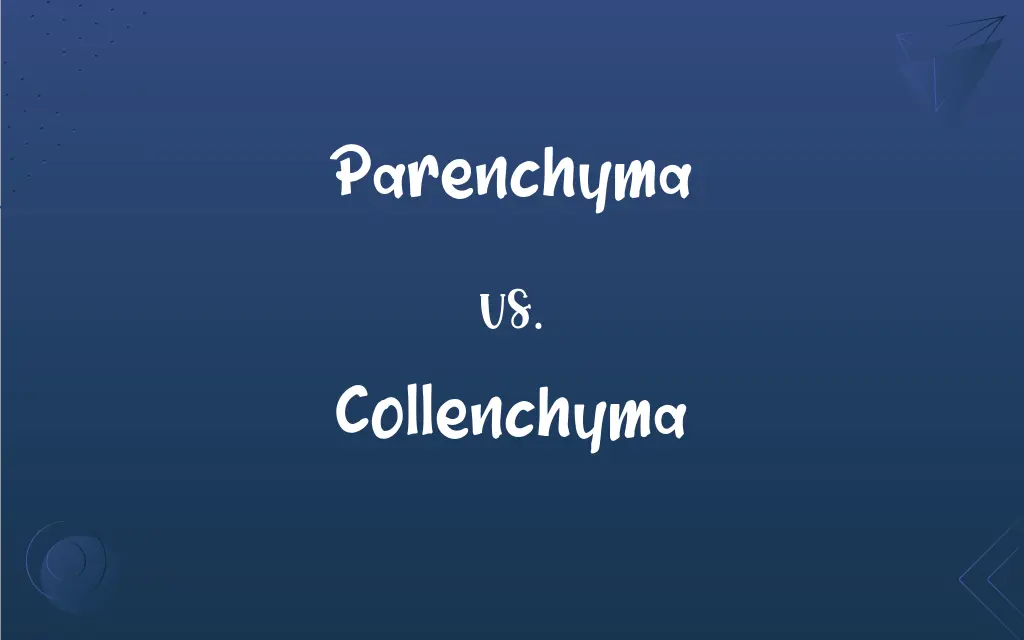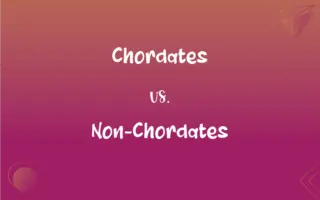Parenchyma vs. Collenchyma: What's the Difference?
Edited by Aimie Carlson || By Harlon Moss || Updated on October 30, 2023
Parenchyma refers to the primary tissue in plants involved in storage, photosynthesis, and regeneration; collenchyma provides support, having thickened, elongated cells.

Key Differences
Parenchyma and collenchyma are both essential types of cells found in plants, serving distinct functions. Parenchyma cells are the most common type of plant cell, and they play versatile roles in storage, photosynthesis, and regeneration. These cells often have a thin and flexible cell wall and are generally involved in metabolic functions. On the other hand, collenchyma cells are elongated and are primarily known for providing support to young plant organs, especially in regions of active growth.
While parenchyma cells are usually isodiametric, meaning they have a roughly similar dimension in all directions, collenchyma cells are elongated. The significant distinction between these two cell types lies in their cell wall composition. Parenchyma cells have uniformly thin cell walls, whereas collenchyma cells have unevenly thickened cell walls. This thickening gives collenchyma its supportive property, helping the plant to withstand mechanical pressures.
One of the significant functions of parenchyma is in photosynthesis. Chlorenchyma, a subtype of parenchyma, contains chloroplasts that carry out this essential process. Collenchyma, on the other hand, does not typically engage in photosynthesis. Instead, its main role is to provide flexibility to the plant, ensuring it doesn't break under the influence of external forces like wind.
Another fascinating aspect of parenchyma cells is their ability to divide and differentiate into other cell types, even after maturation. This characteristic makes them vital for plant healing and regeneration. Collenchyma cells, though less versatile than parenchyma, also play a crucial role in the plant's adaptability to its environment, allowing it to adjust its shape and structure in response to external stimuli.
In sum, while both parenchyma and collenchyma cells are fundamental to a plant's well-being, they serve very different roles: parenchyma in storage, photosynthesis, and regeneration, and collenchyma in providing support and flexibility.
ADVERTISEMENT
Comparison Chart
Function
Storage, photosynthesis, regeneration
Support and flexibility
Cell Shape
Typically isodiametric
Elongated
Cell Wall Thickness
Uniformly thin
Unevenly thickened
Role in Photosynthesis
Contains chloroplasts in chlorenchyma subtype
Typically does not participate
Regeneration Ability
Can divide and differentiate into other cell types
Does not have the same regenerative capabilities
ADVERTISEMENT
Parenchyma and Collenchyma Definitions
Parenchyma
Primary tissue in plants responsible for storage.
The potato's edible part is mainly composed of parenchyma cells storing starch.
Collenchyma
Plant cells providing support and flexibility.
The stringy parts of celery are made of collenchyma tissue.
Parenchyma
Plant cells involved in photosynthesis.
The green color of leaves comes from chlorenchyma, a parenchyma type with chloroplasts.
Collenchyma
Elongated cells that help plants resist mechanical pressures.
The resilience of certain plants to wind is due to the presence of collenchyma cells.
Parenchyma
Cells that play a role in plant regeneration.
After a minor injury to a plant, parenchyma cells can help heal the wound.
Collenchyma
Tissue primarily found in regions of active growth.
In young plants, collenchyma provides essential support during rapid growth phases.
Parenchyma
Fundamental cells with a thin and flexible cell wall.
The soft texture of fruits is due to the presence of parenchyma cells.
Collenchyma
Cells that allow plants to adjust their shape in response to external stimuli.
Collenchyma tissues help plants adapt to varying environmental conditions.
Parenchyma
Cells that can differentiate into various other cell types in plants.
The versatility of parenchyma cells aids in plant growth and adaptation.
Collenchyma
Cells with unevenly thickened cell walls.
The rigidity in young stems arises from collenchyma's thickened cell walls.
Parenchyma
(Anatomy) The tissue characteristic of an organ, as distinguished from associated connective or supporting tissues.
Collenchyma
A supportive tissue of plants, consisting of elongated living cells with unevenly thickened walls.
FAQs
How do collenchyma cells differ from parenchyma cells?
Collenchyma cells provide support with their unevenly thickened cell walls, while parenchyma cells are more versatile and involved in metabolic functions.
Why are collenchyma cells crucial for plants in windy environments?
Their supportive nature allows plants to withstand mechanical pressures like wind.
How are parenchyma cells shaped?
Parenchyma cells are typically isodiametric, having a similar dimension in all directions.
What gives collenchyma cells their supportive property?
Collenchyma cells have unevenly thickened cell walls which provide rigidity and support.
Why are collenchyma cells important for young plants?
Collenchyma cells provide essential support in regions of active growth in young plants.
Can collenchyma cells divide like parenchyma cells?
No, collenchyma cells do not have the same regenerative capabilities as parenchyma.
Can parenchyma cells regenerate?
Yes, parenchyma cells can divide and differentiate into other cell types even after maturation.
What is the significance of chlorenchyma?
Chlorenchyma is a type of parenchyma with chloroplasts that play a role in photosynthesis.
Is the primary function of parenchyma photosynthesis?
While photosynthesis is one of the roles, parenchyma also participates in storage and regeneration.
Can parenchyma cells differentiate into other cell types?
Yes, parenchyma cells can differentiate into various other cell types in plants.
Do parenchyma cells participate in photosynthesis?
Yes, a subtype called chlorenchyma contains chloroplasts that perform photosynthesis.
Where can we commonly find collenchyma cells in plants?
Collenchyma cells are commonly found in young stems and leaves.
Do parenchyma cells store food?
Yes, parenchyma cells play a significant role in storing nutrients like starch.
Are collenchyma cells flexible?
Yes, collenchyma cells provide flexibility, helping plants adjust to their environment.
Are collenchyma cells uniformly shaped?
No, collenchyma cells are elongated in shape.
How do parenchyma cells aid in plant healing?
Parenchyma cells can divide and differentiate, helping in plant healing and regeneration.
Do parenchyma cells have a thick cell wall?
No, parenchyma cells typically have a uniformly thin cell wall.
What are parenchyma cells?
Parenchyma cells are primary plant cells responsible for storage, photosynthesis, and regeneration.
Do collenchyma cells engage in photosynthesis?
Typically, collenchyma cells do not participate in photosynthesis.
Is collenchyma found in mature plants?
While most prominent in young plants, collenchyma can also be found in certain mature plant parts.
About Author
Written by
Harlon MossHarlon is a seasoned quality moderator and accomplished content writer for Difference Wiki. An alumnus of the prestigious University of California, he earned his degree in Computer Science. Leveraging his academic background, Harlon brings a meticulous and informed perspective to his work, ensuring content accuracy and excellence.
Edited by
Aimie CarlsonAimie Carlson, holding a master's degree in English literature, is a fervent English language enthusiast. She lends her writing talents to Difference Wiki, a prominent website that specializes in comparisons, offering readers insightful analyses that both captivate and inform.
































































